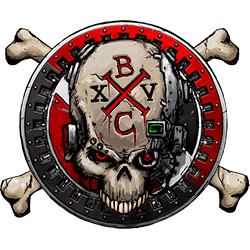The oldest of my unfinished Warhammer 40,000 projects is that of creating a chess set based on the game. I enjoyed playing chess long before WH40K and greatly appreciate finely crafted chess pieces. I began “working” on this project back in the ezBoard days of 3rd edition and have revisited it several times since then. At one point, I even started a larger project in which other members of the community were invited to submit their own WH40K-themed chess sets. That project was called “Regicide” after the in-universe game of the same name and predating the video game of the same name from Hammerfall Publishing (you can find it at the Google Play store and on Steam). Actually, the project has never moved beyond the conceptual stage. Despite my pathetic lack of progress, this is the project that I am most keen on finishing one day.

There are several things that I would like to achieve with my set:
- Recognizability
- Simplicity
- Theme
Recognizability
The key focus of recognizability is that a chess player that isn’t familiar with the Warhammer 40,000 setting should be able to look at the pieces and be able to figure out what each represents. A key component of this is the actual piece – the shape of the piece should look most like what it is supposed to represent. Another element might be decorations on or additions to the piece. For example, the standard chess symbol for the piece might be represented on the model. Alternately/additionally, the symbols might be incorporated into the model bases. However this is done, symbols should be visible on the front and back at a minimum to facilitate recognition by the players, but also on the sides to facilitate recognition by spectators.
Simplicity
This is an offshoot of the recognizability criterion. The goal here is to limit the learning curve to the greatest extent possible. In this, the opposing pieces should be as close as possible in appearance so that non-WH40K players will recognize that the opponent’s pieces correspond with their own pieces. Two virtually identical sets (except for color) would be ideal for this, but the next criterion means that there might be small differences.
Theme
This criterion drives towards the pieces working together thematically, as well as each working on its own thematically. For example, a knight should look like it can move the way a chess knight moves; and the potency of each piece (relative to the others) is appropriate. In addition, the opposing sides should work thematically, representing enemies within the setting.
All these criteria combined have led me to base the set on the Legiones Astartes of the Great Crusade/Horus Heresy/Scouring. As it stands right now, the pieces are as follows:
- King – Standard Bearer
- Queen – Praetor
- Bishop – Librarian/Techmarine
- Knight – Assault
- Rook – Breacher or Terminator (I’m leaning towards the Terminator)
- Pawn – Tactical
I don’t plan to make the sides represent any specific legions, instead just making each generic. Black (actually, a dark grey) and dark red will be the main colors, each with the chess piece symbol marked in white on both shoulder pads and on the backpack (and shield, if they have one).
I’m thinking that I can use different armor types as another way to differentiate the sides. One side would have Mk III armor (Cataphracti for the Terminators) and the other side would have Mk IV armor (Tartaros for the Terminators).
The pieces won’t look like they can be used in regular games of WH40K – they won’t have ‘Eavy Metal paint jobs (or as close as my skills might attempt). Instead, they’ll be [mostly] monochromatic. This reduces some of the distraction for non-WH40K players. The minis will be painted using contrast paints and inks to make the details pop, but I want them to look more like they were carved from a single piece of wood/stone than like regular painted miniatures. They’ll probably have a glossy finish, too.
I’m looking at using the Zone Mortalis: Floor Tile Set for the board.
The bases of the chess pieces will feature a number of elements to distinguish the pieces:
- Height: Pawns being shortest; Rooks, Knights, and Bishops being in the middle; and Queens and Kings having the tallest bases.
- Chess symbols at the front, back, and sides.
The concept is illustrated below. To execute, I’ll need either three or eight types of pieces. Piece A is the middle part of the base and will have the standard symbol on it. The variation here comes in either having a generic piece that I have to apply the symbol either through painting or decals, or having the symbols sculpted onto the bases (so needing six variations for each of the piece types). Piece B is the top/bottom, and Piece C is a spacer that indicates the relative power/importance of the piece. The illustrations aren’t quite to scale and will probably be much wider than they appear in the image. If I had a 3D printer, I’d make them that way. Since I don’t, I’ll either have to commission them or create them the old fashioned way (or resort to turning the pieces out of wood or casting them in resin).




3 Comments
Recommended Comments
Create an account or sign in to comment
You need to be a member in order to leave a comment
Create an account
Sign up for a new account in our community. It's easy!
Register a new accountSign in
Already have an account? Sign in here.
Sign In Now